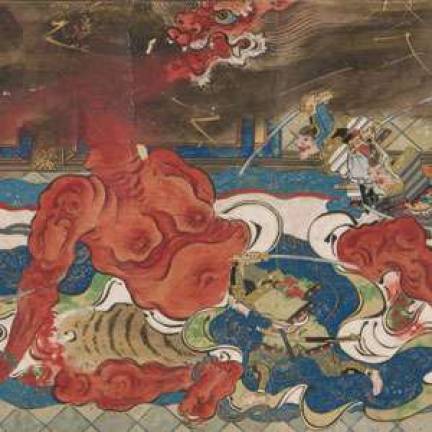The Blur of Modernism

From Japan to Sarah Sze
The advent and subsequent triumph of modernism did much to diminish the role of narrative in the visual arts, insisting, as it did, that the exigencies of craft should take precedence over anything smacking of literature. But modernism is an historical blip-a significant blip, mind you, but a blip all the same. Narratives have dominated world art. To ignore (or downplay) as much is to mistake The Annunciation for a flat surface covered with colors assembled in a certain order.
Thoughts about narrative-about temporal flow, cultural myths and the human imagination's range, influence and probity-came to mind while viewing Storytelling in Japanese Art, an exhibition at The Metropolitan Museum of Art.
Which isn't to suggest that the colors and flat surfaces assembled by the painters and sculptors featured in Storytelling don't merit attention. A story is captivating to the extent to which it is told well, and the artisans responsible for this panel painting, that devotional carving or emaki, a form of illuminated handscroll, tell them well indeed.
In the work, elaborate stylization coexists with acute observation, generalization with specificity, charm with gravity. Hell is rendered in burnt copper tonalities and whiplash rhythms; the seasons with lucid economy. Shibata Zeshin's "The Ibaraki Demon" (ca. 1839?40), the closest Storytelling comes to a showstopper, is a miraculous confluence of line, gesture, character and motion.
The more Sarah Sze accumulates and organizes detritus-the more impressive her meticulous arrangements of this, that and the other thing become-the more you have to wonder what it is she's concealing or, for that matter, running from.
Sarah Sze: Infinite Line, a mid-career exhibition at Asia Society, does everything and goes nowhere simultaneously. Give the artist this much: She imagines what might have happened if Robert Rauschenberg had been a neatnik beholden to Alexander Calder and not the New York School-and if he had been a victim of information overload rather than its messenger.
Immaculate confusion is the result, painfully choreographed and scrupulously inert, though the work hints at pictorial invention. Thetrouble is, Sze is a sculptor-or an installation artist, whatever. Where to begin detailing her materials? Among them are a Rolodex, a tape measure, pocket change, rocks, an upturned driver's license, rolled-up photographs of natural phenomena, a desk fan plugged in and working, exquisitely ordered confetti, a take-out coffee cup from "Bread Corrado Pastry" and string, lots of string. What Sze gleans from Calder is his gift for rendering line as a three-dimensional entity and the theatrical contingencies of his "Circus."
In the end, all those finicky agglomerations of stuff don't coalesce into anything with much vitality, personality or staying power. An ambitious blur of expertise-we should ask more from our artists.
Sarah Sze: Infinite Line Through March 25, Asia Society, 725 Park Ave., 212-288-6400, www.asiasociety.org.
Storytelling in Japanese Art Through May 6, The Metropolitan Museum of Art, 1000 5th Ave., 212-535-7710, www.metmuseum.org.